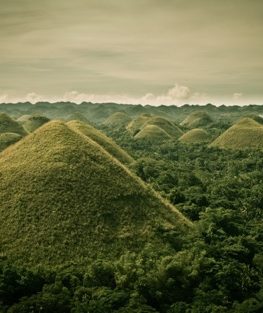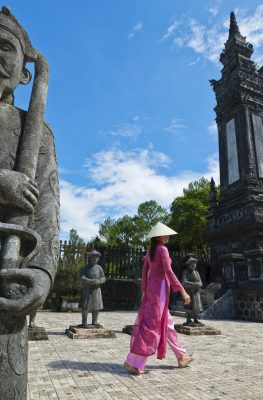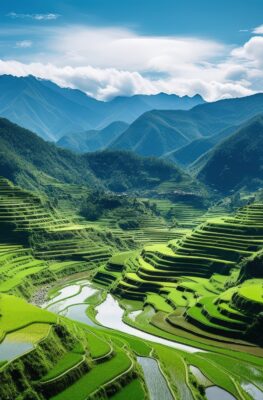Published on December 12, 2017
This week, Claire Madarang shows us her ideal shopping list for Southeast Asia. A veteran writer and researcher, Claire constantly embarks on adventures like backpacking for seven weeks and exploring remote islands and bustling cities alike. Follow her adventures, travel tips, and epiphanies on her blog Traveling Light and her Instagram.

T’nalak cloth in the Philippines. Image courtesy of Claire Madarang.
Blessed with rich cultures and traditions, Southeast Asia encourages travelers to take its treasures home through its souvenirs, which go far beyond the usual key chain or fridge magnet. We’ve put together some shopping ideas for your consideration, the next time you visit one of the area’s many traditional markets:
Indigenous textile products: Colourful and Sacred
Many communities in Southeast Asia have a tradition of painstakingly weaving or dyeing fabrics. The more ethno-linguistic groups a country has, the more diverse its woven patterns. From raw bolts of fabric to finished clothes, bags, and other products, indigenous textiles make unique and vibrant keepsakes.
Indonesia has perhaps the richest and most colorful tradition of hand-dyeing fabric, known as batik in the region. You can get batik sarong, shawls, dresses, trousers, pillowcases, and more, from shops all around the country. You can even try your own hand at making batik when visiting the central Java city of Yogyakarta.
In terms of indigenous woven fabrics, the Philippines has some of the richest and most varied patterns. Bring home bolts of cloth, bags, wallets, and even cloth-covered notebooks from the highlands in the Cordilleras (home to the rice terraces).
Pro tip: Be mindful of the textiles’ use; don’t just buy and use willy-nilly. You don’t want to use a traditional burial blanket, no matter how pretty, as a table cloth! Buy directly from the indigenous peoples’ groups, and ask locals to be sure. This way, you directly support their community livelihood, and ensure you don’t misappropriate sacred patterns for the wrong use.

Lanterns in Hoi An, Vietnam. Image courtesy of Claire Madarang.
Unique handicrafts: Handmade mementos
If you find items special to the destination you’re visiting, and you know you will never tire of looking at them or using them, go ahead and buy! The bright cloth lanterns that illuminate the streets of Hoi An in Vietnam, for example, can be easily brought home; they’re foldable, and only require the addition of a light bulb for use inside your home. These lanterns even look vibrant in the daytime!
(Elsewhere in Vietnam, you can’t go wrong by visiting the Old District in Hanoi, where you’ll find so much more than just lanterns – silk clothes, propaganda posters, and lacquerware only scratch the surface.)
Myanmar is particularly known for its gorgeous lacquerware and accessories. Formerly commissioned by Burmese royalty, the lacquer artisans of Myanmar now cater heavily to the tourist trade.
Buying artwork not only beautifies your home; it also supports the local artist communities. Buy paintings, carvings, and even sculptures that catch your eye, especially those which reflect the destination they come from. For example, the sand paintings in Bagan, Myanmar reflect the area’s deeply-held Buddhist beliefs.
Brunei draws from its long history as a Malay sultanate to manufacture traditionally-crafted regalia like ornamental brass cannons, ceremonial keris (swords) and silverwork, all made and sold at the Brunei Arts and Handicrafts Training Centre by the Brunei River (they also have an outlet at the Airport Departure Lounge, for those last-minute shoppers).

Toraja coffee from Sulawesi, Indonesia. Image courtesy of Mike Aquino.
Food: Explore with your gut
It’s hardly a a long-lasting souvenir, but food lets you relive your travel experience like nothing else. And you have almost endless choices to take home!
In Cambodia, you can’t go wrong by bringing home the area’s famous Kampot-grown peppers, beloved by chefs worldwide for its aromatic goodness when freshly-ground.
Coffee is grown all around the region, with each country touting their own favored beans. The highlands can be particularly rewarding for caffeine fiends, with Kalinga in the Northern Philippines and Toraja in Sulawesi, Indonesia selling some of the world’s best Arabica coffee.
In Cameron Highlands, Malaysia, the rarefied air offers a different treat: tea, which you can buy in ample quantities throughout town.
If all else fails, bring home some ready-to-eat snacks and instant noodles from convenience stores. For instant noodles, Malaysia’s curry noodles are particularly spicy, and Vietnam’s instant pho can partially satisfy your cravings for this noodle dish while you are still planning your next trip.






